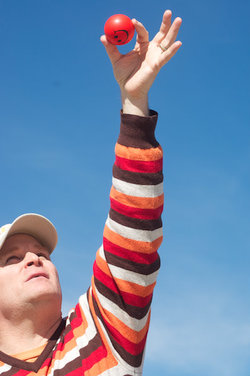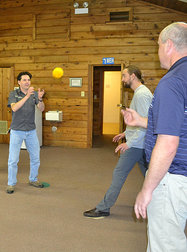
Magic Ball (sorry I lost the internet reference to this one - thanks to the contributor!!) Use any sort of ball (or other object for that matter - could be a magic rock) and dub it the Magic Ball. Circle up your group. You (the facilitator) start off the magic. For me (picture to the right) the ball became an apple I'm picking from a tree. I then passed the magic ball to the person on my right. When (and if) this player feels the magic she tells and acts out for the group what the ball turns into for her. The magic ball continues to be passed around to the right with "each student acting out what the ball 'is' in a way that communicates it to other participants - by shape, weight, size, function, etc." Players can "pass" by saying "I'm not feeling the magic yet" and then moving the ball on to the next player.
COMMENTARY: This activity provides the opportunity for participants to share their voice in front of a group, offers the opportunity for group members to listen to each other, and provides an opportunity to be creative. There are times when I'll go around the circle more than once to really force the creative thinking process. This also helps me to emphasize the possibilities of creative problem solving that will be coming up during our time together.
The next two "easy does it" activities come from a handout prepared by Laurie Gilmer for the Texas Physical Education Conference in 1998.
Human Mixmaster All players stand in a circle. The object of the activity is to have all players walk directly across the diameter of the circle and reform back into a circle. The circle should be exactly the same as before, but with players standing on the other side of the circle. After players have done this once or twice, have them keep their hands at their sides and not bump into others as they cross the circle. If a player accidentally bumps into someone else, he or she must make a "BEEP" sound. After a couple practices with this challenge, the final challenge for the circle of players would be to move across with eyes closed and reform their circle - use the "BEEP" if a bump occurs.
COMMENTARY: I love the simplicity of the directions for this one - just reform the same circle on the other side. When I play "Across" (that's what I call this one), I use spots. In this version there is no need for spots. I did cringe a bit (maybe you did too) when I first read the "eyes closed" challenge - I'm so use to having "bumpers up" when eyes are closed. But when I did try this one with hands to the sides there was no damage at all. Movement was very slow. Participants were allowed to talk to one another. And, if there were bumps, players just "BEEPed" (usually laughed too) and then moved on. Now, I have to say, I will teach and use bumpers up to some groups if I believe it's needed.
Inuit Ball Pass Players stand (or Laurie says kneel - but this could be tough on the knees) in a circle formation. With a safe round object (maybe the one used in Magic Ball) players pass off the object person-to-person with flat, open hands (palm up). The objective is to pass off the object as fast as possible all the way around the circle (I add, "the object only touching fingers and palms") without grasping it. Start out with each player using two hands then challenge everyone to use only one hand.
COMMENTARY: As some of you know with the activity "Warp Speed" players may choose to form a line in order to accomplish the task as fast as possible. For this one the objective is to pass off the object all the way "around the circle" - so I make my groups stay in a circle formation. Thinking at this moment, Inuit Ball Pass might be a good precursor to the Warp Speed activity.
BONUS from Laurie
Standing Together (I remember doing this as a kid way back when - still a nice group challenge.) Players seated in a circle holding hands or locking arms at the elbows try to collectively stand up without using hands to push off the floor.
Let me know how it goes. Leave me a comment below.
All the best,
Chris Cavert







 RSS Feed
RSS Feed